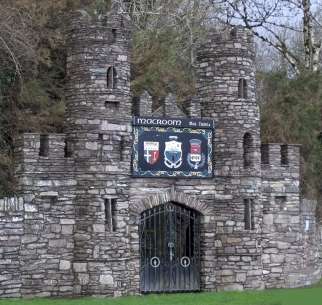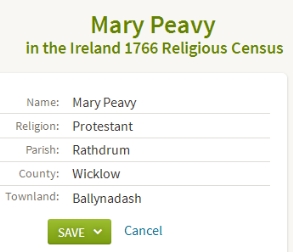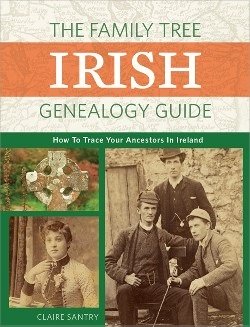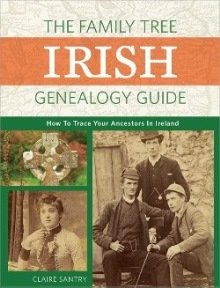- Home ›
- Irish Census ›
- 1766 Religious Census
Ireland's 1766 religious census
This page explores the 1766 Religious Census, the only survey of the population's faith affiliations authorised on a national level. For information about other, similar historical censuses exploring the religious leanings of our Irish ancestors, follow this link.
 The Religious Census of 1766 survives for Macroom (Cork)
The Religious Census of 1766 survives for Macroom (Cork)The 1766 island-wide survey census was authorised by the Irish Parliament in March of that year. Precise reasons for its commission are lost to us, but it may have been
for ecclesiastical administrative purposes or even for security reasons.
Political atmosphere
Although concerns about the loyalty of Roman Catholics had been on the wane for some decades, harsh Penal Laws still restricted their religious, political and economic options, and the term 'Papist' was still regarded by some as synonymous with 'Rebel'.
However, it is unlikely to be a coincidence that just two months before the authorisation, the Old Pretender (the son of the exiled Catholic King James II of England, who the Pope recognised as the legitimate king of Great Britain) died.
On his death, the Pope acknowledged the ruling Protestant monarchy as legitimate. This effectively removed the threat of Rome-inspired rebellion among the Catholics of Ireland. Within just a few years, the Penal Laws began to be relaxed, and the (very) long path to Catholic Emancipation was started.
Resolution
The House of Lords resolution instructed all archbishops and bishops to direct the parish ministers of their dioceses to return a list of the families in their parishes, 'distinguishing which are Protestants and which are Papists, as also a list of the several reputed Popish priests and friars residing in their parishes.'
That was it. No further instruction about how this religious census was to be carried out, no clear advice about what information was required, and no set format for the information to be submitted.
Fulfillment
In view of the lack of clarity of how the 1766 religious census was to be carried out, there's no surprise to find that the census returns take a number of forms, including:
- A numerical summary of Protestant families and the same for Papist families in the parish as a whole or by townland
- Lists showing names of the heads of families, with their religion, for the parish or by townland
- Lists showing names and religion of the heads of families, plus the number of people (including servants) of each religion in the household
- Similar to above but broken down into landholders and tenants
- Any of the above but broken down into Established Church/Episcopalians, Dissenters/Presbyterians, and other smaller denominations
- A complete survey of all Protestants only.
What survives
Most of the original returns were lost in the fire at the Public Records Office in 1922. Surviving returns include a number for the dioceses of Armagh, Cashel & Emly, Cork & Ross, and Waterford.
Fortunately, extensive transcripts were not held at the PRO, so these have survived but they don't cover all areas. The areas best represented by surviving transcript fragments include North Cork, Limerick, Londonderry, Louth and Wicklow.
Where to view the 1766 religious census
The collection of original and transcripted returns is not held in one central depository so these are not necessarily the easiest records to access. Apart from the Arthur Tenison Groves transcripts (see below), all records are held in hard copy in Ireland.
Here are some options:
The Public Record Office of Northern Ireland's free Name Search database
allows you to search the 1766 Religious Census index by your ancestor's
name and, if you know it, location. More than 20,600 householders are
indexed in this database, with a positive result displaying precisely
the same information as shown in the Mary Peavy example from Ancestry below.
- Ancestry has indexed about 11,000
names taken from transcripts created by A T Groves. The index is part of
the UK
and Ireland collection. Nearly all
the records relate to parishioners in the north of Ireland.

- The same 11,000 names, unindexed and arranged by parish or townland, are available on microfilm (films 100173 and 100220) through the Family Search Library.
- For details of where to find surviving returns for the whole of Ireland, download the Guide to the Religious Census of 1766 by the National Archives of Ireland (NAI).
 Ancestry's Index - example search result
Ancestry's Index - example search result- The Public Record Office of Northern Ireland's free Name Search database
allows you to search the 1766 Religious Census index by your ancestor's
name and, if you know it, location. More than 20,600 householders are
indexed in this database, with a positive result displaying precisely
the same information as shown in the Mary Peavy example from Ancestry below.
- Ancestry has indexed about 11,000 names taken from transcripts created by A T Groves. The index is part of the UK and Ireland collection. Nearly all the records relate to parishioners in the north of Ireland. This index is, as far as I'm aware, the only form of access to the 1766 religious census available online.
- The same 11,000 names, unindexed and arranged by parish or townland, are available on microfilm (films 100173 and 100220) through the FamilySearch Library.
- For details of where to find surviving returns for the whole of Ireland, download the Guide to the Religious Census of 1766 by the National Archives of Ireland (NAI).
Records
of genealogical value
While the above mentioned NAI's Guide to the Religious Census of 1766 is useful, it does not differentiate between those census returns that contain material useful for genealogy research (ie names, occupations, addresses and ages) and those that provide merely statistical information.
I have, therefore, devised my own list of returns that might be of value for genealogy purposes. Depending on the device you're using to view this page, it's either in the right-hand column or at the foot of the page.
I have, therefore, devised my own list of returns that might be of value for genealogy purposes. Scroll down to Fragments box.
If you see one of 'your' parishes in the list, you can find out where the transcripts are held in the NAI Guide. (While I have tried to be accurate, please double check with the holding body shown in the NAI Guide, and let me know of any errors you come across.)
► More Irish census pages
The Family Tree Irish Genealogy Guide
Written by the creator of Irish Genealogy Toolkit and Irish Genealogy News, 'The Family Tree Irish Genealogy Guide' is full of advice, tips and strategies to ease what can be a challenging journey.
Its guidance will be useful to any researcher of Irish heritage, but especially for the target Irish-American researcher who's struggling to work back to Ireland from their immigrant ancestor.
Publisher: Penguin
ISBN: 9781440348808 / 240 pages.
The Family Tree Irish Genealogy Guide
Written by the creator of Irish Genealogy Toolkit and Irish Genealogy News, 'The Family Tree Irish Genealogy Guide' is full of advice, tips and strategies to ease what can be a challenging journey.
Its guidance will be useful to any researcher of Irish heritage, but especially for the target Irish-American researcher who's struggling to work back to Ireland from their immigrant ancestor.
Publisher: Penguin Random House.
ISBN: 9781440348808 / 240 pages.
Fragments
Surviving fragments of the 1766 Religious Census, which contain names and other information relevant to genealogy research, are listed below. See 'What Survives' section of the main text for a fuller explanation.
Antrim: Ahoghill, Ballintoy, Ballymoney, Ballynure.
Armagh: Creggan.
Cavan: Protestants only in Kinawley, Lavey, Lurgan, Munterconnaught.
Cork: Aghabulloge, Aghada, Ardagh, Ballintemple, Ballyhay, Ballynoe, Carrigdownane, Carrigrohanebeg, Castlelyons, Castletownroche, Churchtown, Clenor, Clondrohid, Clondulane, Clonfert, Clonmeen, Clonmult, Clonpriest, Cloyne, Coole, Farahy, Garrycloyne, Glanworth, Grenagh, Ightermurragh, Imphrick, Inishcarra, Kildorrery, Kilmahon, Kilnamartry, Kilshannig, Kilworth, Knockmourne, Lisgoold, Litter, Macroney, Macroom, Magourney, Mallow, Marshalstown, Matehy, Middleton, Mogeely, Mourneabbey, Roskeen, Shandrum, St. Nathlash, Templemolaga, Whitechurch, Youghal, Rathbarry, Ringrone, Dunbulloge, Kilmichael.
Derry: Artrea, Desertlyn, Magherafelt, Boveagh, Comber, Drumachose, Desertmartin. Protestants only in Ballynascreen, Banagher, Donaghedy, Dungiven, Leck.
Donegal: Donoghmore diocese. Protestants only in Leck and Raphoe.
Down: Kilbroney, Seapatrick, Inch, Shankill.
Dublin: Crumlin, Castleknock, Taney.
Fermanagh: Boho, Derryvullen, Devenish, Kinawley, Rossory.
Kildare: Ballycommon, Clonaghlis, Kildare. Catholic housholders in Kilrush.
Kilkenny: Catholic householders only in Portnascully.
Laois: Lea.
Limerick: Abington, Cahircomey, Cahirelly, Carrigparson, Clonkeen, Kilkellane, Tuogh. Protestants only in Croagh, Kilscannel, Nantinan and Rathkeale.
Louth: Ardee, Ballymakenny, Beaulieu, Carlingford, Charlestown, Clonkeehan, Darver, Drumiskan, Kildermock, Kileshiel, Louth, Mapastown, Philipstown, ShanLIs, Smarmore, Stickallen, Tallonstown, Termonfeckin. Creggan.
Meath: Protestants only in Ardbraccan.
Tipperary: Ballingarry, Uskeane. Athassel, Ballintemple, Ballycahill, Ballygriffin, Boytonreth, Brickendown, Bruis, Clerihan, Clonbeg, Cloneen, Clonoulty, Clonbolloge, Clonpet, Colman, Cordangan, Corrogue, Cullen, Dangandargan, Drum, Dustrileague, Erry, Fethard, Gaile, Grean, Horeabbey.
Tyrone: Aghaloo, Artrea, Carnteel, Clonfeacle, Derryloran, Donaghendry, Drumglass, Dungannon, Kildress, Tullyniskan, Errigal Keerogue, Kildress.
Wexford: Protestants only in Edermine.
Wicklow: Ballymaslamey, Drumkay, Dunganstown, Kilpoole, Rathdrum, Rathnew.

